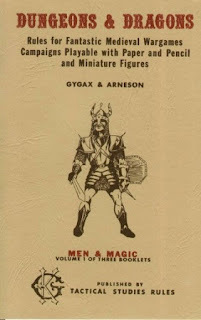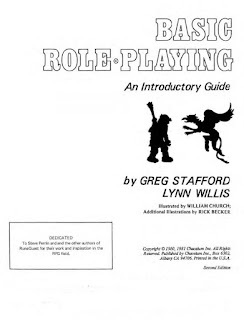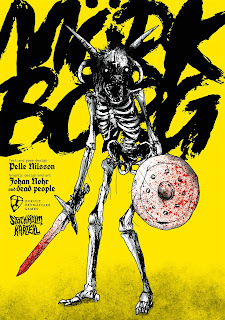Three Models of Character Advancement
One of the aspects of Secrets of sha-Arthan that's been bedeviling me lately is character advancement. I've been trying to find an approach that both makes sense mechanically and feels appropriate to the setting’s tone and structure. I believe I’ve finally managed to thread that particular needle (something I’ll be talking about in more detail on Grognardia Games Direct next week). In the course of wrestling with the issue, though, I found myself reflecting more broadly on how roleplaying games have historically handled advancement and how those choices shape the experience of play.
After all, one of the more foundational elements of any RPG is its system for character advancement. How characters improve over time has a profound impact on gameplay. It shapes player incentives and directs the focus not just of individual sessions but of entire campaigns. While there are countless variations and hybrid models, I think most systems fall into three broad categories, each exemplifying a particular design philosophy. These categories are neither mutually exclusive nor exhaustive, but they are, in my experience, among the most common approaches used in games both old and new.
 Objective Advancement: The Dungeons & Dragons Model
Objective Advancement: The Dungeons & Dragons ModelThe traditional Dungeons & Dragons approach to advancement is probably the one most familiar to readers of this blog. Characters gain experience points (XP) for doing certain things, primarily defeating monsters and acquiring treasure. In OD&D and its descendants, including AD&D 1e, treasure was by far the more significant contributor to XP, sometimes by a significant factor over combat.
This approach to advancement is appealing in part because of its objectivity. The rules are clear about what earns XP and how much doing so nets them. Players know what kinds of activities will lead to advancement and this transparency encourages a particular style of play. Exploration, clever planning, risk management, and even negotiation (to avoid unnecessary fights) all emerge naturally when the primary goal is treasure not combat.
That said, this system is also clearly an artifact of game design rather than a simulation of anything. Despite attempts to explain it retroactively, there’s no in-world explanation for why recovering a chest of gold coins makes a thief better at climbing walls or a cleric suddenly able to cast a new level of spell. Advancement in D&D is largely a mechanical abstraction, divorced from the diegetic logic of the game world. Some players find this lack of in-setting justification jarring. Others, myself included, regard it as an acceptable (and often productive) mechanical contrivance.
 Diegetic Advancement: The RuneQuest/BRP Model
Diegetic Advancement: The RuneQuest/BRP ModelA very different approach is found in games like RuneQuest, Call of Cthulhu, and other members of the Basic Role-Playing (BRP) family. Here, advancement is tied directly to what the character actually does during play. If a character successfully uses a skill, such as 1H Sword or Library Use, there’s a chance that skill will improve. The logic is intuitive: you get better at things by doing them.
This system is intensely diegetic. Improvement follows in-world logic and feels grounded in the character’s actual experiences. It avoids the abstraction of XP and provides a satisfying sense of verisimilitude. There's also something engaging about watching a character slowly improve in the areas he focuses on. Some characters become jacks-of-all-trades and others become specialists.
However, this comes at the cost of bookkeeping. Every skill use must be tracked and players must remember to mark those skills for later improvement rolls. In long-term play, this can become fiddly, particularly when characters have a large number of skills. It also risks encouraging behavior where players deliberately use low-probability skills just to have a chance at improving them, regardless of context.
Despite these quirks, BRP’s approach has had lasting influence, especially on games that prioritize character immersion and realism over abstract mechanics.
 Narrative Advancement: The Milestone Model
Narrative Advancement: The Milestone ModelThe third common approach is often called “milestone” advancement. There are no experience points to tally nor skills to track. Instead, characters improve whenever the referee (or game system) deems that a “major” event has occurred, such as defeating a key antagonist, completing a quest, finishing an adventure, and so on.
This approach is most common in contemporary games, like Mörk Borg and its various spin-offs, though a versions of it exist even in current editions of D&D and Pathfinder. Its appeal lies in its flexibility and ease of use. It removes the need for careful tracking of treasure hoards or skill rolls and aligns character advancement with the narrative arc of a campaign.
However, it also introduces a great deal of subjectivity. What counts as a "milestone?" How long should characters go between them? Without clear guidance, milestone advancement can feel arbitrary and dependent more on the referee's whims than player action. It also risks undermining the sense of accomplishment that comes from overcoming difficult challenges. If advancement is inevitable, tied to narrative beats rather than earned through in-game actions, some players may feel less invested in their characters’ growth.
Moreover, milestone systems often flatten the pacing of advancement. In classic XP-based systems, players can level up at unpredictable times, sometimes quickly after a particularly lucrative dungeon crawl and, at other times, slowly, as they scrounge for minor treasures. That unevenness contributes to a feeling of dynamic progress. Milestone systems, by contrast, tend to regularize advancement, which some may appreciate but others may find dull.
Each of these advancement models brings with it certain strengths and certain limitations. The classic D&D approach encourages player choice and strategic planning at the cost of diegetic coherence. The BRP model is immersive and logical, but mechanically heavy. Milestone advancement is smooth and flexible but often lacks clarity and player-driven incentives. Designers and referees must both consider the kind of play they want to foster. Do they want a game that rewards careful play and tangible goals? One that simulates the experience of a character’s development? Or one that supports a tightly woven narrative with minimal overhead?
There are, of course, many other variations and hybrid approaches. Games like Pendragon offer their own takes on advancement, blending elements of these three models in novel ways. Other games, like classic Traveller, all but eschew mechanical advancement altogether. Nevertheless, these three remain, I think, the primary modes by which roleplaying games have handled the question of character growth.
As always, I am probably forgetting one (or more!) obvious examples of alternate approaches to advancement. If you know of a system that doesn’t fall easily into any of these categories or otherwise deviates from the scheme I've laid out here, I’d love to hear about it in the comments.James Maliszewski's Blog
- James Maliszewski's profile
- 3 followers



